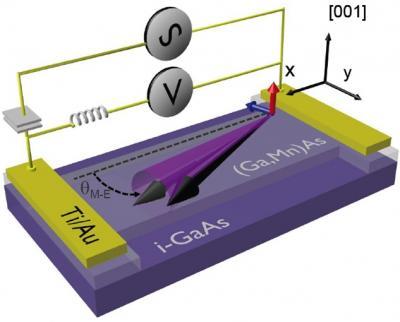By now, almost everyone understands computers and that current technologies for writing, storing, and reading information are either charge-based or spin-based.
Spin-based devices operate on the principle that in materials like iron, electron spins generate magnetism and the position of the north and south pole of the magnet can be used to store the zeros and ones. This technology is behind both magnetic stripe cards and terabyte computer hard disks. Since these devices are based on spin, they are more robust against charge perturbations but the drawback is that in order to reverse the north and south poles of the magnet, i.e., flip the zero to one or vice versa, the magnetic bit has to be coupled to an electro-magnet or to another permanent magnet.
Semiconductor flash or random access memories are prime examples among the large variety of charge-based devices because they easily electrically manipulate and detect their electronic charge states - representing the "zeros" and "ones".
The downside is that weak perturbations such as impurities, temperature change, or radiation can lead to uncontrolled charge redistributions and, as a consequence, to data loss.
If instead one could flip the poles by an electric signal without involving another magnet, a new generation of memories can be envisaged combining the merits of both charge and spin-based devices. Now, researchers have discovered a new physical phenomenon that allows them to manipulate the state of a magnet by electric signals.

An electrically shaken GaMnAs magnet. Credit: Ill./©: Jairo Sinova
In order the shake a magnet electrically without involving an electro-magnet or another permanent magnet one has to step out of the realm of classical physics and enter relativistic quantum mechanics. Einstein's relativity allows electrons subject to electric current to order their spins so they become magnetic.
The researchers took a permanent magnet GaMnAs and by applying an electric current inside the permanent magnet they created a new internal magnetic cloud, which was able to manipulate the surrounding permanent magnet.
The observed phenomenon is closely related to the relativistic intrinsic spin Hall effect which Jörg Wunderlich, Jairo Sinova, and Tomas Jungwirth discovered in 2004 following a prediction of Sinova and co-workers in 2003. Since then it has become a text-book demonstration of how electric currents can magnetize any material.
"Ten years ago we predicted and discovered how electric currents can generate pure spin-currents through the intrinsic structure of materials. Now we have shown how this effect can be reversed to manipulate magnets by the current-induced polarization. These new phenomena are a major topic of research today since they can lead to new generation of memory devices. Besides our on-going collaborations, this research direction couples very well with on-going experimental research here in Mainz. Being part of this world-leading research and working with superb colleagues is an immense privilege and I am very excited about the future," says co-author Professor Jairo Sinova of the Institute of Physics at Johannes Gutenberg University Mainz (JGU),





Comments